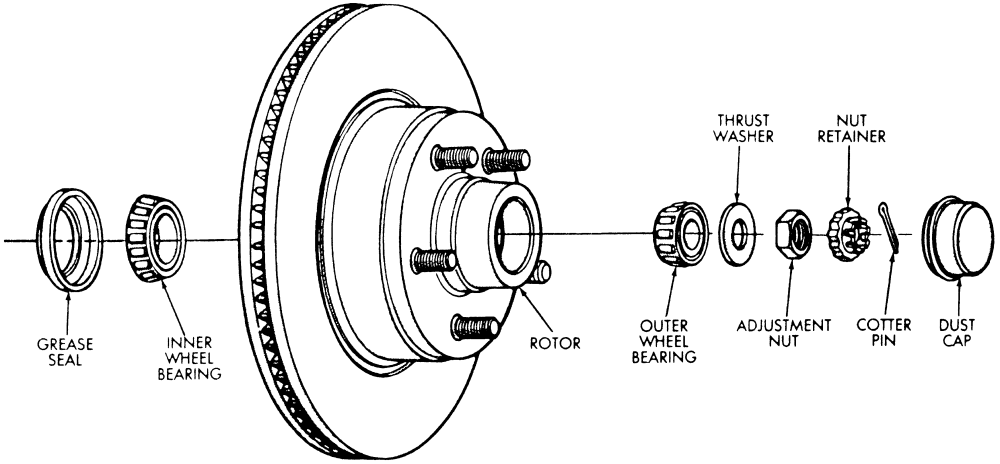Step by Step Instructions
1. Safe jacking
2. Removing the wheel and hub
3. Removing the grease seal and bearings
4. Inspection
5. Hand packing the bearings
6. Reassembly
7. Adjusting the pre-load
8. Replacing bearings
Safe jacking
1. Park the camper on firm and level ground.
2. Block the trailer tires on the opposite side securely so that no forward or rearward movement is possible.
3. Jack up the camper following the manufacturer's instructions.
4. Secure the camper on jack stands of adequate capacity front and rear.
Removing the wheel and hub
1. Undo the wheel nuts and remove the wheel
2. Pry off the dust cap using a flat bladed screwdriver
3. Straighten out the cotter pin that holds the bearing nut and remove it
4. Remove the bearing nut and washer
5. Gently pull the brake drum forward while cupping the hub opening with your hand to keep the front bearing from falling to the ground. The outer race stays in the drum, while the inner race and roller bearings come out as an assembled unit.
6. Place the front bearing, bearing nut and the bearing washer in a clean container
Removing the grease seal and rear bearing
1. Place the brake drum face down so that the back of the drum is accessible
2. Pry out the grease seal. This will be replaced in a further step.
3. Lift out the rear bearing and place it in the container with the rest of the parts
4. Don't mix up the bearings if you are doing more that one wheel at a time - each bearing must mate with it's original race ( no prejudice intended). The bearings wear in by a certain amount and need to be matched with their respective counterparts.
Inspection
1. Thoroughly clean the bearings and other parts in a solvent (not gasoline!) until all the old grease is removed. Set the aside to dry completely or blow dry with compressed air. Don't use the air pressure to spin the bearing, as damage could result to the bearing or to your person!
2. Clean the hub and spindle.
3. Inspect the bearing races for heat discoloration, pitting, scoring and any unevenness.
4. Inspect the bearing for damage as above. Any out of round rollers, cracked roller cages and rough running will indicate replacement is required.
5. The bearing and both inner and outer races must be replaced as a set.
6. Inspect the brake drum for pitting and excessive wear especially if the brake shoes were allowed to wear down to bare metal.
7. Inspect the brake magnet surface for excessive or uneven wear.
8. If the brake drum and magnet have been saturated with grease from a failed seal, replace the shoes and magnet, and have the drum turned or machined to renew the surfaces.
Hand packing the bearings
1. Place a walnut sized gob of wheel bearing grease in one palm.
2. Grasp the bearing with the other hand so that the wider end is facing the grease.
3. What you want to do is force the grease into the gap between the inner race and the outer cage so that it squeezes up through the rollers and out the top.
4. Press the bearing down into the grease in a rocking motion and continue until the grease oozes up.
5. Rotate the bearing 1/4 turn, at a time, and continue until the bearing is completely filled with grease.
Reassembly
1. Put some grease into the interior of the hub with your fingers. A walnut sized amount is sufficient. Spread it around the circumference of the hub.
2. Place the inner packed bearing into its place in the hub.
3. Place a new seal on the hub and tap it into place with a hammer until it seats fully.
4. Be sure to wipe off any grease that finds its way onto the outer flat surface of seal.
5. Replace the drum onto the axle spindle, insert the outer bearing, thrust washer and axle nut.
Preloading the bearings
1. Tighten the axle nut by hand until it is tight. Tighten another 1/4 turn with pliars or wrench.
2. Spin the drum several times to distribute the grease evenly in the bearings.
3. Back off the nut with the pliers or wrench, until loose and then retighten finger tight.
4. Insert a new cotter pin to lock the nut in place and bend it over the spindle.
5. Re-install the dust cap, wheel and tire, and hubcap.
6. Now is a very good time to adjust the brakes. See the brake adjusting page for more info.
7. Wash hands vigorously for 15 minutes!
Replacing the bearings
The bearing must be replaced with a complete new bearing with the inner and outer races.
1. The inner races are pressed into place in the hub and must be driven out.
2. Use a brass punch to catch the edge of the race by passing it through the inverted hub. A few good whacks with a hammer should drive out the old race.
3. Place the new race into position and tap it in with the hammer and punch. Take care not to mar the surface of the race.
4. Pack, reassemble, and preload the bearings.
I have had good luck with campers and boat trailer bearings over the years, but I like to think it was because I did some maintanence in the driveway every couple of years. I know of several friends that had their weekend of fishing or camping ruined because a frozen bearing sheared and axle and now their boat/camper was on the side of the road and only an expensive repair or tow was going to get the problem resolved but only after wrecking their weekend excursion.
ALSO, I like Bearing Buddies available at most all auto stores. Two sizes fit most all wheels. Smaller diameter for smaller wheels and the larger diameter for larger wheels. Usually 1 squirt of grease into the Bearing Buddy at the beginning of each season is enough to protect you for the year.
769
1 Guest(s)



